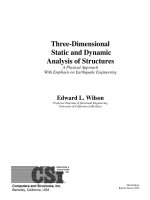108 dynamic analysis sap2000 basics
Bạn đang xem bản rút gọn của tài liệu. Xem và tải ngay bản đầy đủ của tài liệu tại đây (887.37 KB, 98 trang )
Dynamic Analysis
With Emphasis On
Wind and Earthquake Loads
BY
Ed Wilson
Professor Emeritus of Structural Engineering
University of California, Berkeley
October 22, 1999
Summary Of Presentation
1. General Comments
2. History Of The Development of SAP
3. Computer Hardware Developments
4. Methods For Linear and Nonlinear Analysis
5. Generation And Use Of LDR Vectors and
Fast Nonlinear Analysis - FNA Method
6. Example Of Parallel Engineering
Analysis of the Richmond - San Rafael Bridge
Structural Engineering Is
The Art Of Using Materials
Which We Do Not Fully Understand
To Build Structural Systems
Which Can Only Be Approximately Analyzed
To Withstand Forces
Which Are Not Accurately Known
So That We Can Satisfy
Our Responsibilities
In Regards To Public Safety
FUNDAMENTALS OF ANALYSIS
1. UNDERSTAND PHYSICS OF PROBLEM
2. CREATE COMPUTER MODEL
3. CONDUCT PARAMETER STUDIES
4. VERIFICATION OF RESULTS
STATIC AND DYNAMIC EQUILIBRIUM
ENERGY BALANCE
5. FIELD OR LABORATORY TESTS
FIELD MEASUREMENTS
REQUIRED TO VERIFY
1. MODELING ASSUMPTIONS
2. SOIL-STRUCTURE MODEL
3. COMPUTER PROGRAM
4. COMPUTER USER
VIBRATION
DEVICES
CHECK OF RIGID
DIAPHRAGM
APPROXIMATION
FIELD MEASUREMENTS OF
PERIODS AND MODE SHAPES
MODE T
FIELD
T
ANALYSIS
Diff. - %
1 1.77 Sec. 1.78 Sec. 0.5
2 1.69 1.68 0.6
3 1.68 1.68 0.0
4 0.60 0.61 0.9
5 0.60 0.61 0.9
6 0.59 0.59 0.8
7 0.32 0.32 0.2
- - - -
11 0.23 0.32 2.3
15 th Period
T
FIELD
= 0.16 Sec.
FIRST DIAPHRAGM
MODE SHAPE
COMPUTERS
1957 TO 1999
IBM 701 - PENTIUM III
1957 1999
C = Cost of $1,000,000 $1,000
Computer
S = Monthly Salary $1000 $10,000
Engineer
C/S RATIO 1,000 .1
1957
1999
Time
A Factor Of 10,000
Reduction In 42 Years
$
Floating Point Speed Comparison
Year COMPUTER Op/Sec Relative Speed
1981 CRAY-XMP 30,000,000 600
Definition of one Operation A = B + C*D
1997 Pentium Pro 10,000,000 200
1998 Pentium II 17,000,000 350
1999 Pentium III 45,000,000 900
FORTRAN 64 bits - REAL*8
1963 CDC-6400 50,000 1
1967 CDC-6600 200,000 4
1974 CRAY - 1 3,000,000 60
1988 Intel 80387 100,000 2
1980 VAX - 780 100,000- 2-
1990 DEC-5000 3,500,000 70
1994 Pentium 90 3,500,000 70
1995 DEC - ? 14,500,000 280
Floating Point Speed Comparison - PC
Year CPU Speed MHz Op/Sec Normalized
1980 8080 4 200 1
Definition of one Operation A = B + C*D
1984 8087 10 13,000 65
1988 80387 20 93,000 465
1991 80486 33 605,000 3,O25
1994 PENTIUM 66 1,210,000 6,050
1996 Pentium-Pro 200 10,000,000 50,000
Microsoft FORTRAN 64 bits - REAL*8
1996 PENTIUM 133 5,200,000 26,000
1998 Pentium II 333 17,000,000 85,000
1999 Pentium III 450 45,000,000 225,000
The Sap Series
Structural Analysis Programs
1969 To 1999
S A P
STRUCTURAL ANALYSIS
PROGRAM
ALSO A PERSON
“ Who Is Easily Deceived Or Fooled”
“ Who Unquestioningly Serves Another”
"The slang name S A P was
selected to remind the user that
this program, like all programs, lacks
intelligence.
It is the responsibility of the
engineer to idealize the structure
correctly and assume responsibility
for the results.”
Ed Wilson 1970
From The Foreword Of
The First SAP Manual
The Sap Series Of Programs
1969 SAP With User Defined Ritz Vectors
1971 SOLID SAP For Static Loads Only
1972 SAP IV With Full Dynamic Response
1973 NONSAP Now ADINA
1980 SAP 80 NEW Program for PC , Elements and Methods
1983 SAP 80 CSI Added Pre and Design Post Processing
1989 SAP 90 Large Capacity on PC
1991 SADSAP R & D Program With Nonlinear Elements
1997 SAP 2000 Added Graphical User Interface
S
T A T I C
A N D
D Y N A M I C
S T R U C T U R A L
A N A L Y S I S
P R O G R A M
How Can Engineers Be
Convinced To Use New And
Improved Methods Of Analysis ?
1. Give Them New Capabilities Such
As 2 and 3d Nonlinear Analyses
2. Or, The Program Must Be Easy To Use,
Fast On A PC, And Have
FANCY COLORED GRAPHICS
SAP2000
A Good Computer Program
1. The Fundamental Equations Must Represent
The Real Physical Behavior Of The Structure
2. Accurate , Efficient And Robust Numerical
Methods Must Be Used
3. Must Be Programmed In Portable Language
In Order To Justify Development Cost
4. Must Have User-friendly Pre And Post Processors
5. Ability To PLOT All Possible Dynamic Results As A
Function of TIME - Only SAP 2000 Has This Option
Numerical Methods for
The Seismic Analysis of
Linear and Nonlinear
Structural Systems
DYNAMIC EQUILIBRIUM
EQUATIONS
M a + Cv + Ku = F(t)
a = Node Accelerations
v = Node Velocities
u = Node Displacements
M = Node Mass Matrix
C = Damping Matrix
K = Stiffness Matrix
F(t) = Time-Dependent Forces
PROBLEM TO BE SOLVED
M a + C v + K u = fi g(t)i
For 3D Earthquake Loading
THE OBJECTIVE OF THE ANALYSIS
IS TO SOLVE FOR ACCURATE
DISPLACEMENTS and MEMBER FORCES
= - Mx ax - My ay - Mz az
Σ
METHODS OF DYNAMIC ANALYSIS
For Both Linear and Nonlinear Systems
÷
STEP BY STEP INTEGRATION - 0, dt, 2 dt N dt
USE OF MODE SUPERPOSITION WITH EIGEN OR
LOAD-DEPENDENT RITZ VECTORS FOR FNA
For Linear Systems Only
÷TRANSFORMATION TO THE FREQUENCY
DOMAIN and FFT METHODS
RESPONSE SPECTRUM METHOD - CQC - SRSS
STEP BY STEP SOLUTION METHOD
1. Form Effective Stiffness Matrix
2. Solve Set Of Dynamic Equilibrium
Equations For Displacements At
Each Time Step
3. For Non Linear Problems
Calculate Member Forces For
Each Time Step and Iterate for
Equilibrium - Brute Force Method









